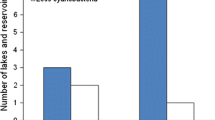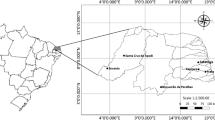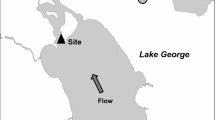Abstract
Analysis of an 18-year dataset from seven shallow lakes in Florida provides evidence of hydrologic factors controlling dynamics of cyanobacteria blooms. Depth was the most important variable, and there was a synergistic effect with flushing. When the lakes were deep, rainfall led to water discharges and disruption of stagnant conditions that maintained blooms. Factors commonly associated with bloom formation (temperature) or suppression (high organic color, which can be a light-limiting factor) did not play a significant role. A conceptual model illustrates how blooms are regulated. First, the presence of bloom-forming species, high concentrations of nutrients, and lack of large zooplankton create a potential for blooms. Second, climate cycles influence yearly rainfall, resulting in wet years and droughts that affect lake water level and volume. This either stimulates blooms (drought, shallow) or suppresses them (wet, deep). Finally, proximal drivers such as a rain events and a flush of water suppress blooms. The results illustrate how climate variability and weather can control cyanobacteria blooms by affecting several processes long known to influence bloom formation, and provide insight into how climate change might affect occurrence of blooms in nutrient-enriched shallow lakes.










Similar content being viewed by others
References
Abtew, W. & P. Trimble, 2010. El Niño Southern Oscillation link to south Florida hydrology and water management applications. Water Resource Management 24: 4255–4271.
Beaver, J. R., K. C. Scotese, E. E. Manis, S. T. K. Juul, K. Carroll & T. R. Renicker, 2015. Variation in water residence time is the primary determinant of phytoplankton and zooplankton composition in a Pacific Northwest Reservoir ecosystem (Lower Snake River, USA). River Systems 21: 261–275.
Bouvy, M., R. M. Molica, S. De Oliveira, M. Marinho & B. Beker, 1999. Dynamics of a toxic cyanobacterial bloom (Cylindrospermopsis raciborskii) in a shallow reservoir in the semi-arid region of northern Brazil. Aquatic Microbial Ecology 20: 285–297.
Bouvy, M., D. Falcao, M. Marinho, M. Pagano & A. Moura, 2000. Occurrence of Cylindrospermopsis (Cyanobacteria) in 39 Brazilian tropical reservoirs during the 1998 drought. Aquatic Microbiology 23: 13–27.
Brasil, J., J. L. Attayde, F. R. Vasconcelos, D. D. F. Dantas & V. L. M. Huszar, 2015. Drought-induced water-level reduction favors cyanobacteria blooms in tropical shallow lakes. Hydrobiologia. https://doi.org/10.1007/s10750-015-2578-5.
Cai, W., A. Santoso, G. Wang, et al., 2015. ENSO and greenhouse warming. Nature Climate Change 5: 849–859.
Catalano, M. J. & M. S. Allen, 2011. A whole-lake density reduction to assess compensatory responses of gizzard shad Dorosoma cepedianum. Canadian Journal of Fisheries and Aquatic Sciences 68: 955–968.
Catalano, M. J., M. S. Allen, M. H. Schaus, D. G. Buck & J. R. Beaver, 2010. Evaluating short-term effects of omnivorous fish removal on water quality and zooplankton at a subtropical lake. Hydrobiologia 655: 159–169.
Cheung, M. Y., S. Liang & J. Lee, 2013. Toxin-producing cyanobacteria in freshwater: a review of the problems, effects on drinking water safety, and efforts for protecting public health. Journal of Microbiology 51: 1–10.
Conley, D. J., H. W. Paerl, R. W. Howarth, D. F. Boesch, S. P. Seitzinger, K. E. Havens, C. Lancelot & G. E. Likens, 2009. Controlling eutrophication: nitrogen and phosphorus. Science 323: 1014–1015.
Coveney, M. F. 2016. Water Quality Changes in Lake Apopka, Florida, and the St. Johns River Water Management District’s Restoration Program. Technical Memorandum 56. St. Johns River Water Management District, Palatka.
Coveney, M. F., E. F. Lowe, L. E. Battoe, E. R. Marzolf & R. Conrow, 2005. Response of a eutrophic, shallow subtropical lake to reduced nutrient loading. Freshwater Biology 50: 1718–1730.
Cózar, A., M. Bruno, N. Bergamino, B. Ubeda, L. Bracchini, A. M. Dattilo & S. A. Loiselle, 2012. Basin-scale control on the phytoplankton biomass in Lake Victoria, Africa. PLoS ONE 7: e29962.
Darchambeau, F., A. V. Borges, H. Sarmento, B. Leporcq, P. M. Lsumbisho, G. Alunga, P. M. Masilya & J. P. Descy, 2013. Teleconnections between ecosystem productivity and climate indices in a tropical great lake. Geophysical Research Abstracts 15, EGU2013-9919-1.
Fox, J. & S. Weisberg, 2011. An R Companion to Applied Regression, 2nd ed. Sage, Thousand Oaks.
Fulton III, R. S. 2016. Nutrient Loading and Water Quality Trends in the Upper Ocklawaha Basin Lakes Through 2014. Technical Memorandum 54-2. St. Johns River Water Management District, Palatka.
Fulton III, R. S., W. F. Godwin & M. H. Schaus, 2015. Water quality changes following nutrient loading reduction and biomanipulation in a large shallow subtropical lake, Lake Griffin, Florida, USA. Hydrobiologia 753: 243–263.
Ha, K., E. A. Cho, H. W. Kim & G. J. Joo, 1999. Microcystis bloom formation in the lower Nakdong River, South Korea: importance of hydrodynamics and nutrient loading. Marine and Freshwater Research 50: 89–94.
Havens, K. E., 2008. Cyanobacteria blooms: effects on aquatic ecosystems. Advances in Experimental Medicine and Biology 619: 745–759.
Havens, K. E. & J. R. Beaver, 2011. Composition, size and biomass of zooplankton in large productive Florida lakes. Hydrobiologia 668: 49–60.
Havens, K. E. & H. W. Paerl, 2015. Climate change at a crossroad for control of harmful algal blooms. Environmental Science and Technology. https://doi.org/10.1021/acs.est.5b03990.
Havens, K. E., T. L. East & J. R. Beaver, 1996. Experimental studies of zooplankton–phytoplankton–nutrient interactions in a large subtropical lake (Lake Okeechobee, Florida, USA). Freshwater Biology 36: 579–597.
Havens, K. E., E. J. Phlips, M. F. Cichra & B. L. Li, 1998. Light availability as a possible regulator of cyanobacteria species composition in a shallow subtropical lake. Freshwater Biology 39: 547–556.
Havens, K. E., R. S. Fulton III, J. R. Beaver, E. E. Samples & J. Colee, 2016. Effects of climate variability on cladoceran zooplankton and cyanobacteria in a shallow subtropical lake. Journal of Plankton Research. https://doi.org/10.1093/plankt/fbw009.
Hillebrand, H., C. D. Dürselen, T. Kirschtel, et al., 1999. Biovolume calculation for pelagic and benthic microalgae. Journal of Phycology 35: 403–424.
Ibelings, B. W. & K. E. Havens, 2008. Cyanobacterial toxins: a qualitative meta-analysis of concentrations, dosage and effects in freshwater, estuarine and marine biota. Advances in Experimental Medicine and Biology 619: 685–744.
Iglesias, C., N. Mazzeo, M. Meerhoff, G. Lacerot, J. M. Clemente, F. Scasso, C. Kruk, G. Goyenola, J. Garcia-Alonso, S. L. Amsinck, J. C. Paggi, S. J. de Paggi & E. Jeppesen, 2011. High predation is of key importance for dominance of small-bodied zooplankton in warm shallow lakes: evidence from lakes, fish exclosures and surface sediments. Hydrobiologia 667: 133–147.
IPCC, 2014. Climate Change 2014: Synthesis Report. Contribution of Working Groups I, II and III to the Fifth Assessment Report of the Intergovernmental Panel on Climate Change. IPCC, Geneva: 151 pp.
Jeppesen, E., M. Meerhoff, B. A. Jacobsen, et al., 2007. Restoration of shallow lakes by nutrient control and biomanipulation – the successful strategy varies with lake size and climate. Hydrobiologia 581: 269–285.
Kopp, J. F. & G. D. McKee, 1983. Methods for Chemical Analysis of Water and Wastewater. EPA-600/4-79-020. United States Environmental Protection Agency, Washington, DC.
Kosten, S., V. L. M. Huszar, E. Bécares, et al., 2012. Warmer climates boost cyanobacterial dominance in shallow lakes. Global Change Biology 18: 118–126.
Lacerot, G., C. Kruk, M. Lurling, et al., 2012. The role of subtropical zooplankton as grazers of phytoplankton under different predation levels. Freshwater Biology 58: 494–503.
Lee, S. K., B. E. Mapes, C. Wang, D. B. Enfield & S. J. Weaver, 2014. Springtime ENSO phase evolution and its relation to rainfall in the continental US. Geophysical Research Letters 41: 1673–1680.
McNabb, C. D., 1960. Enumeration of freshwater phytoplankton concentrated on the membrane filter. Limnology and Oceanography 5: 57–61.
Meerhoff, M., C. Iglesias, F. Teixeira de Mello, et al., 2007. Effects of habitat complexity on community structure and predator avoidance behavior of littoral zooplankton in temperate versus subtropical shallow lakes. Freshwater Biology 52: 1009–1021.
Moss, B., J. Madgwick & G. Phillips, 1997. A Guide to the Restoration of Nutrient-Enriched Shallow Lakes. WW Hawes, Inc., London: 180.
Nõges, T., P. Nõges & R. Laugaste, 2003. Water level as a the mediator between climate change and phytoplankton composition in a large shallow temperate lake. Hydrobiologia 506: 257–263.
O’Reilly, C. M., S. Sharma, D. Gray, et al., 2015. Rapid and highly variable warming of lake surface waters around the globe. Geophysical Research Letters. https://doi.org/10.1002/2015GL066235.
Paerl, H. W. & J. Huisman, 2009. Climate change: a catalyst for global expansion of harmful cyanobacterial blooms. Environmental Microbiology Reports 1: 27–37.
Paerl, H. W. & T. G. Otten, 2013. Harmful cyanobacterial blooms: causes, consequences and controls. Microbial Ecology 65: 995–1010.
Paerl, H. W., W. S. Gardner, K. E. Havens, A. R. Joyner, M. J. McCarthy, S. E. Newell, B. Qin & J. T. Scott, 2016. Mitigating cyanobacterial harmful algal blooms in aquatic ecosystems impacted by climate change and anthropogenic nutrients. Harmful Algae 54: 213–222.
Reichwaldt, E. S. & A. Ghadouani, 2012. Effects of rainfall patterns on toxic cyanobacterial blooms in a changing climate: between simplistic scenarios and complex dynamics. Water Research 46: 1372–1393.
Reynolds, C. S., 2006. The Ecology of Phytoplankton. Cambridge University Press, Cambridge: 535 p.
Rodusky, A. J., B. Sharfstein, K. R. Jin & T. L. East, 2005. Thermal stratification and the potential for enhanced phosphorus release from the sediments of Lake Okeechobee, USA. Lake and Reservoir Management 21: 330–337.
Schaus, M. H., M. J. Vanni, T. E. Wissing, M. T. Bremigan, J. E. Garvey & R. A. Stein, 1997. Nitrogen and phosphorus excretion by detritivorous gizzard shad in a reservoir ecosystem. Limnology and Oceanography 42: 1386–1397.
Srifa, A., E. J. Phlips, M. F. Cichra & J. C. Hendrickson, 2016. Phytoplankton dynamics in a subtropical lake dominated by cyanobacteria: cyanobacteria like it hot and sometimes dry. Aquatic Ecology 50: 163–174.
Ter Braak, C. J. F. & P. Smilauer, 2002. CANOCO Reference Manual and User’s Guide to Canoco for Windows: Software for Canonical Community Ordination (Version 4.5). Microcomputer Power, Ithaca.
USACE, 1999. Lake Okeechobee Regulation Schedule Study, Environmental Impact Statement. US Army Corps of Engineers, Jacksonville District, Jacksonville.
Van Cleave, K., J. D. Lenters, J. Wang & E. M. Verhamme, 2014. A regime shift in Lake Superior ice cover, evaporation, and water temperature following the warm El Niño winter of 1997–1998. Limnology and Oceanography 59: 1889–1898.
Acknowledgements
The authors are grateful to the field crews and laboratory staff at the St. Johns River Water Management District for field collections and analyzing the water quality samples, and to two anonymous reviewers whose constructive comments led to improvements in the paper.
Author information
Authors and Affiliations
Corresponding author
Additional information
Guest editors: S. Nandini, S.S.S. Sarma, Erik Jeppesen & Linda May / Shallow Lakes Research: Advances and Perspectives
Rights and permissions
About this article
Cite this article
Havens, K.E., Ji, G., Beaver, J.R. et al. Dynamics of cyanobacteria blooms are linked to the hydrology of shallow Florida lakes and provide insight into possible impacts of climate change. Hydrobiologia 829, 43–59 (2019). https://doi.org/10.1007/s10750-017-3425-7
Received:
Revised:
Accepted:
Published:
Issue Date:
DOI: https://doi.org/10.1007/s10750-017-3425-7




